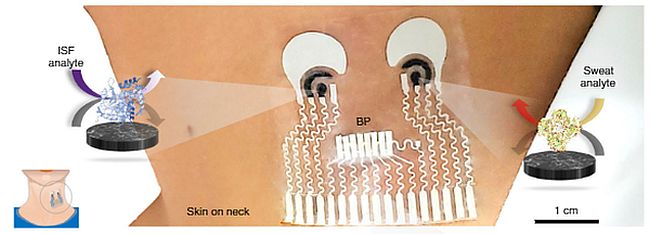
Monitoring cardiovascular signals and multiple biochemical levels together on one tiny wearable patch has always been a far-fetched dream in the nanotech world. Scientists across the globe are still trying to figure it out however, researchers at the University of California San Diego have done something extraordinary in soft, stretchy skin patch.
One wearable
Xu research group has formulated an epidermal patch that is able to track not only heart rate and blood pressure but also the levels of glucose simultaneously.
Lu Yin, one of the lead researchers, said the wearable sensors will assist people with underlying medical conditions to track their own health in the comforts of their home. Also, the patch will reduce regular clinical visits to avoid the COVID-19 pandemic.
The device aims to target people who are managing high blood pressure and diabetes. Although the patch can also detect beginning of sepsis.
Sepsis: is a medical condition in which chemicals that were meant to cure an infection leads to inflammation within the body. If not detected at the right time, sepsis can cause catastrophic results like multiple organ failure.
Non-invasive skin-worn device
Xu group’s revolutionary “one wearable” has three different sensors embedded on a single platform. These sensors collect information in a non-invasive way. Thus, patients will have to deal with no discomfort of arterial line insertion to obtain blood pressure and related readings.
The patch is product of stretchy polymers that has an ability to conform to the skin. One sensor corresponds to tracking blood pressure while the other two are chemical sensors that measure levels of either lactate, caffeine, alcohol and glucose.
Higher lactate is a biomarker of physical exertion, where the level of required oxygen is less leading to an increase in lactate.
Blood pressure sensor
The blood pressure sensor is placed at the center. Small ultrasound transducers are joined together to a conductive ink. When voltage is introduced, it sends ultra sound waves into the body.
When this wave is hit by an artery, it obviously bounces back, which is further detected by the sensor. This signal is translated into blood pressure reading.

Chemical sensors
The chemical sensors are two electrodes on either side of the patch. Right side electrode corresponds to the detection of lactate, caffeine and alcohol.
Once pilocarpine (medication) is introduced into skin, this in turn will induce sweat. Then electrode will do its job of sensing chemical substances.
The electrode in the left side is to detect glucose. It is done by initiating minor electrical current through the skin to give out interstitial fluid to measure the level of glucose in it.
Structural and interference issues
Removing interference between the sensors’ signals was one of the biggest roadblocks in developing the tiny microelectronics.
Researchers maintained a distance of 1cm to counteract the challenge since they don’t want to compromise on the nano size of the device.
Physically shielding the sensors from each other was the second problem that they had to solve. These chemical sensors have their respective hydrogels to record readings. So, they preferred solid ultrasound gel over the liquid version to avoid leakage and interference issues.

Takeaway
To make the entire system wearable, researchers are also looking forward to the subsequent version. As per the team, the next version could be wireless, that is, it will not be connected to a power source.
Researchers also envision their soft skin patch can offer a convenient alternative for individuals who need constant tracking of blood pressure and other vital signs including but not limited to patients in ICU and infants in NICU.
As of now these procedures involve injecting catheters deep within patient’s arteries. And simultaneously tethering to many hospital monitors. Xu group’s skin stamp will eliminate all these extra measures.



